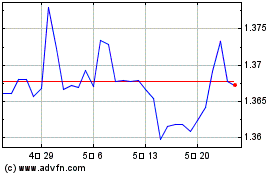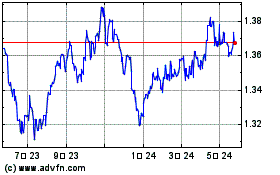Commodity Currency's Slide As Crude Oil Prices Drop
06 2월 2025 - 1:18PM
RTTF2
The commodity-linked currencies such as Australia, the New
Zealand and the Canadian dollars weakened against their major
counterparts in the Asian session on Thursday, as the crude oil
prices settled sharply lower after data showed a sharp jump in U.S.
crude inventories last week.
Concerns about the outlook for oil demand also weighed on
prices. West Texas Intermediate Crude oil futures for March settled
at $71.03 a barrel, losing $1.67 or 2.29 percent, while the
benchmark Brent crude futures dipped 0.7 percent to $75.64 in
European trade.
OPEC+ plans to gradually increase oil output from April also
added uncertainty to global energy markets, potentially offsetting
Iran tensions.
U.S. President Donald Trump issued an executive order
reinstating a "maximum pressure" campaign against Iran, targeting
Tehran's oil exports.
He also proposed a U.S. takeover of the Gaza Strip at a press
conference with the Israeli PM.
U.S. crude stocks rose by 5.03 million barrels in the week ended
Jan. 31, according to data from the American Petroleum
Institute.
Concerns over a global trade war weighed, even though there were
amicable measures from both the U.S. and China.
The weak trade data from Australia also led to the downturn of
the Australian dollar.
Data from the Australian Bureau of Statistics showed that
Australia posted a seasonally adjusted merchandise trade surplus of
A$5.085 billion in December. That was shy of expectations for
A$6.560 billion and was down from the downwardly revised A$6.792
billion in November.
Exports were up 1.1 percent on month to A$44.027 billion, driven
by metal ores and minerals; exports rose 4.8 percent in the
previous month.
Imports jumped 5.9 percent on month to A$38.942 billion, driven
by capital goods; imports were up 1.7 percent a month earlier.
Expectations of an interest rate cut from the Reserve Bank of
Australia (RBA) also contributed to the fall of Australian dollar.
Around 95 percent of the traders now bet for a chance of a rate cut
from the current 4.35 percent to 4.10 percent.
In the Asian trading today, the Australian dollar fell to a
3-day low of 95.28 against the yen, from yesterday's closing value
of 95.93. The aussie may test support around the 93.00 region.
The aussie dropped to 1.6596 against the euro, from Wednesday's
closing value of 1.6548. On the downside, 1.69 is seen as the next
support level for the aussie.
Against the U.S. and the Canadian dollars, the aussie edged down
to 0.6261 and 0.8976 from yesterday's closing quotes of 0.6283 and
0.8995, respectively. The next possible downside target for the
aussie are seen around 0.60 against the greenback and 0.88 against
the loonie.
The NZ dollar fell to a 3-day low of 86.26 against the yen, from
yesterday's closing value of 86.83. The kiwi may test support near
the 84.00 region.
Against the U.S. and the Australian dollars, the kiwi edged down
to 0.5687 and 1.1048 from Wednesday's closing quotes of 0.5687 and
1.1048, respectively. If the kiwi extends its downtrend, it is
likely to find support around 0.54 against the greenback and 1.12
against the aussie.
The kiwi edged down to 1.8336 against the euro, from Wednesday's
closing value of 1.8283. On the downside, 1.86 is seen as the next
support level for the kiwi.
The Canadian dollar fell to a 3-day low of 106.06 against the
yen and a 2-day low of 1.4352 against the U.S. dollar, from
yesterday's closing quotes of 106.65 and 1.4316, respectively. If
the loonie extends its downtrend, it is likely to find support
around 103.00 against the yen and 1.48 against the greenback.
Against the euro, the loonie edged down to 1.4905 from
Wednesday's closing value of 1.4884. The loonie may test support
near the 1.52 region.
Looking ahead, Germany's construction PMI survey results for
January, U.K. construction PMI survey data for January and Eurozone
retail sales data for December are slated for release in the
European session.
At 7:00 am ET, the Bank of England is set to announce its
monetary policy decision. The BoE is expected to cut its benchmark
rate by a quarter-point to support economic growth.
Markets widely expect the BoE to lower the bank rate to 4.50
percent from 4.75 percent. The BoE had reduced the rate by 25 basis
points each in August and November last year.
At 9:15 am ET, the BoE governor Andrew Bailey will deliver a
speech about the monetary policy decision at a press
conference.
In the New York session, U.S. weekly jobless claims data and
Canada Ivey PMI data for January are slated for release.
the rising expectation that the Reserve Bank of Australia (RBA)
will cut its interest rates for the first time since November 2020
contributes to the AUD's downside. Money markets are now pricing in
nearly a 95% chance of a rate cut from the current 4.35% to
4.10%.
US Dollar vs CAD (FX:USDCAD)
외환 차트
부터 1월(1) 2025 으로 2월(2) 2025

US Dollar vs CAD (FX:USDCAD)
외환 차트
부터 2월(2) 2024 으로 2월(2) 2025
